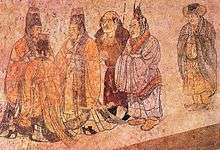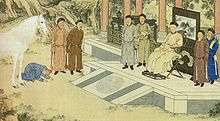Imperial Chinese Tributary System
_with_Listing_of_the_Sea_Route_from_China_to_Japan.jpg)
The Imperial Chinese Tributary System or Cefong System(Chinese: 天朝冊封體制 or 中華帝國朝貢體系) is a term created by John King Fairbank to describe "a set of ideas and practices developed and perpetuated by the rulers of China over many centuries".[1] Conceptually, it consisted of a network of loose international relations focused on China which facilitated trade and foreign relations. Political actors within the "tributary system" were largely autonomous and in almost all cases, virtually independent. Although generally applied to all Chinese polities, this "loose set of expectations and precedents" only really existed in the late Ming and early to middle Qing dynasties.[2]
Definition
In a hierarchical order, actors are "integrated vertically with highly defined superordinate and subordinate positions." What is distinctive about the Chinese hierarchical order is that such superordinate and subordinate positions were largely symbolic in nature rather than involving China's direct and coercive domination of other actors.[3]
The term tribute system is a Western invention. There was no Chinese word for what scholars consider the tribute system today, nor did East Asian contemporaries recognize it as a distinct institution or a "system." The concept was developed in the postwar United States by historian John King Fairbank to refer to "a set of ideas and practices developed and perpetuated by the rulers of China over many centuries." To Fairbank, the international order was an extension of the Confucian hierarchic and nonegalitarian social order of China; the more the culture-based theory of Chinese superiority was accepted by actors in the periphery, the more likely they were to participate in the tribute system.[1]— Ji-Young Lee
The "tribute system" as a term is strictly speaking, a Western invention. There was no equivalent term in the Chinese lexicon to describe what would be considered the "tribute system" today, nor was it envisioned as an institution or system. John King Fairbank created the "tribute system" theory in postwar United States to describe "a set of ideas and practices developed and perpetuated by the rulers of China over many centuries."[1]
The "tribute system" is often associated with a "Confucian world order", under which neighboring states complied and participated in the "tribute system" to secure guarantees of peace, investiture, and trading opportunities.[4] Actors engaged in the "tribute system" by performing "symbolic obeisance".[5] One member acknowledged another's position as superior, and the superior would bestow investiture to confirm their status as a part of the system.[6] Actors within the "tribute system" were virtually autonomous and carried out their own agendas despite sending tribute, as was the case with Japan, Korea, Ryukyu Kingdom, and Vietnam.[3] Nor did they necessarily subscribe to a sinocentric world or mimic Chinese institutions in cases such as the Inner Asians who manipulated Chinese tribute practices without adopting China's political system.[7]
History

Tributary relations emerged during the Tang dynasty as Chinese rulers started perceiving foreign envoys bearing tribute as a "token of conformity to the Chinese world order".[8]
The Ming founder Zhu Yuanzhang adopted a maritime prohibition policy and issued tallies to "tribute-bearing" embassies for missions. Missions were subject to limits on the number of persons and items allowed.[9]
In 1404, Ashikaga Yoshimitsu accepted the Chinese title "king of Japan", and for a brief period until his death in 1408, Japan was an official tributary of the Ming dynasty. Yoshimitsu was the first and only Japanese ruler in the early modern period to accept a Chinese title.[10]

The Manchus invaded Joseon (Korea) and forced it to become a tributary in 1636, due to Joseon's continued support and loyalty to Ming, and then conquered China to establish the Qing dynasty. However, the Manchus, whose ancestors had been subordinate to Korean kingdoms,[12] were viewed as barbarians by the Korean court, which, regarding itself as the new "Confucian ideological center" in place of Ming, continued to use the Ming calendar in defiance of Qing, despite sending tribute missions.[13] Meanwhile, Japan avoided direct contact with Qing China and instead manipulated embassies from neighboring Joseon and Ryukyu to make it falsely appear as though they came to pay tribute.[14]
According to a 2018 study in the Journal of Conflict Resolution covering Vietnam-China relations from 1365 to 1841, the relations could be characterized as a "hierarchic tributary system".[15] The study found that "the Vietnamese court explicitly recognized its unequal status in its relations with China through a number of institutions and norms. Vietnamese rulers also displayed very little military attention to their relations with China. Rather, Vietnamese leaders were clearly more concerned with quelling chronic domestic instability and managing relations with kingdoms to their south and west."[15]
Thailand was always subordinate to China as a vassal or a tributary state since the Sui dynasty until the Taiping Rebellion of the late Qing dynasty in the mid-19th century.[16] The Sukhothai Kingdom established official relations with the Yuan dynasty during the reign of King Ram Khamhaeng.[17] Wei Yuan, the 19th century Chinese scholar, considered Thailand to be the strongest and most loyal of China's Southeast Asian tributaries, citing the time when Thailand offered to directly attack Japan to divert the Japanese in their planned invasions of Korea and the Asian mainland, as well as other acts of loyalty to the Ming dynasty.[18] Thailand was welcoming and open to Chinese immigrants, who dominated commerce and trade, and achieved high positions in the government.[19]
Tributary relations
Rejection
Kingdoms along China's North-Western Frontier often struggled to enter the Imperial tributary system. Beijing often rejected tribute missions, and then lavished gifts and benefits to help soothe the drawn-out and complex conflicts now known as the Ming-Turpan Border Wars.
Mansur then abandoned large-scale military expeditions, though he continued to sanction raids on China to attain his objectives. Instead he offered tribute, occasionally dispatching a dozen or more embassies a year. He was apparently eager to obtain the Chinese gifts granted to foreign embassies, and therefore limited his incursions.[20]
Arbitration
Warfare between tributary states was arbitrated by the Chinese emperor. Malacca and Vietnam were both tributaries to China. Malacca sent envoys to China again in 1481 to inform the Chinese that while going back to Malacca in 1469 from a trip to China, the Vietnamese attacked them, castrating the young and enslaving them. The Malaccans reported that Vietnam was in control of Champa and also that the Vietnamese sought to conquer Malacca, but the Malaccans did not fight back because of a lack of permission from the Chinese to engage in war. The Chinese Emperor scolded them, ordering the Malaccans to strike back with violent force if the Vietnamese attacked.[21]
Non-intervention
The Ming dynasty declined to intervene under the isolationist and anti-interventionist Hongwu Emperor when the Vietnamese attacked Champa, giving only a rebuke.[22] The Chinese again did not intervene in the 1471 Vietnamese invasion of Champa, when Vietnam destroyed Champa. Both Vietnam and Champa were tributary states.
Investiture
Members of the Chinese "tributary system" were often invested with patents of authority. As early as ancient China, investiture was given to non-Chinese neighbors as a concrete expression of the loose reign policy.[23] The rulers of Joseon in particular sought to legitimate their rule through reference to Chinese symbolic authority. On the opposite side of the tributary relationship spectrum was Japan, whose leaders could hurt their own legitimacy by identifying with Chinese authority.[24]
Trade
The tribute system also functioned as international trade with China and could be profitable to tributary members, as was the case with Korea. Thus, there was an economic incentive to be a member of the tributary system.[25]
Replicating the tribute system
During the Nguyễn Dynasty (1802–1945), Vietnam's rulers copied the Imperial Chinese system, declaring themselves Emperors on the Chinese Confucian model and attempting to create a Vietnamese Imperial tributary system.[26]
See also
References
Citations
- 1 2 3 Lee 2017, pp. 28-29.
- ↑ John E. Wills. Past and Present in China's Foreign Policy: From "Tribute System" to "Peaceful Rise". (Portland, ME: merwinAsia
- 1 2 Lee 2017, p. 15-16.
- ↑ Lee 2017, p. 9.
- ↑ Lee 2017, p. 12.
- ↑ Lee 2017, p. 13.
- ↑ Lee 2017, p. 17.
- ↑ Lee 2017, p. 18.
- ↑ 2014, p. 19.
- ↑ Lee 2017, p. 19.
- ↑ Millward, James A. (2007), Eurasian crossroads: a history of Xinjiang, Columbia University Press, pp. 45–47, ISBN 0231139241
- ↑ Early Modern China and Northeast Asia: Cross-Border Perspectives https://books.google.com/books?id=6p1NCgAAQBAJ&lpg=PA36&pg=PA36#v=onepage&q&f=false
- ↑ Lee 2017, p. 23.
- ↑ Lee 2017, p. 24.
- 1 2 "War, Rebellion, and Intervention under Hierarchy: Vietnam–China Relations, 1365 to 1841". Journal of Conflict Resolution. doi:10.1177/0022002718772345.
- ↑ Gambe, Annabelle R. Overseas Chinese Entrepreneurship and Capitalist Development in Southeast Asia. LIT Verlag Münster. p. 99. ISBN 9783825843861. Retrieved 19 July 2016.
- ↑ Chinvanno, Anuson. Thailand’s Policies towards China, 1949–54. Springer. p. 24. ISBN 9781349124305. Retrieved 19 July 2016.
- ↑ Leonard, Jane Kate. Wei Yuan and China's Rediscovery of the Maritime World. Harvard Univ Asia Center. pp. 137–138. ISBN 9780674948556. Retrieved 19 July 2016.
- ↑ Gambe, Annabelle R. Overseas Chinese Entrepreneurship and Capitalist Development in Southeast Asia. LIT Verlag Münster. p. 100–101. ISBN 9783825843861. Retrieved 19 July 2016.
- ↑ Rossabi 1976
- ↑ Royal Asiatic Society of Great Britain and Ireland. Straits Branch, Reinhold Rost (1887). Miscellaneous papers relating to Indo-China: reprinted for the Straits Branch of the Royal Asiatic Society from Dalrymple's "Oriental Repertory," and the "Asiatic Researches" and "Journal" of the Asiatic Society of Bengal, Volume 1. Trübner & Co. p. 252. Retrieved 2011-01-09.
- ↑ Edward L. Dreyer (1982). Early Ming China: a political history, 1355-1435. Stanford University Press. p. 117. ISBN 0-8047-1105-4. Retrieved 2010-11-28.
- ↑ Lee 2017, p. 33.
- ↑ Lee 2017, p. 3.
- ↑ A New History of Korea Lee Ki-baik
- ↑ Alexander Woodside (1971). Vietnam and the Chinese model: a comparative study of Vietnamese and Chinese government in the first half of the nineteenth century (reprint, illustrated ed.). Harvard Univ Asia Center. p. 234. ISBN 0-674-93721-X. Retrieved June 20, 2011.
Sources
- Vohra, Ranbir (1999), China's Path to Modernization: A Historical Review from 1800 to the Present (3rd ed.), Prentice Hall, ISBN 0-13-080747-8
- Yu, Ying-shih (1967), Trade and Expansion in Han China, Berkeley and Los Angeles, California: University of California Press, retrieved June 20, 2011
- Sima, Qian; Watson, Burton (1993), Burton Watson, ed., Records of the grand historian: Han dynasty, 2 (3rd ed.), Columbia University Press, ISBN 0-231-08167-7, retrieved June 20, 2011
- Hussain, A Imtiaz (2004), Tyranny of soft touches: interculturalism, multiculturalism, and 21st century international relations, Universidad Iberoamericana, ISBN 968-859-538-1, retrieved June 20, 2011
- Lee, Ji-Young (2017), China's Hegemony: Four Hundred Years of East Asian Domination, Columbia University Press
- Smits, Gregory (1999), Visions of Ryukyu: identity and ideology in early-modern thought and politics, Honolulu, HI: University of Hawaii Press, ISBN 0-8248-2037-1, retrieved June 20, 2011
- Britannica, Educational Publishing (2010), Kenneth Pletcher, ed., The History of China, The Rosen Publishing Group, ISBN 1-61530-181-X, retrieved June 20, 2011
- Rossabi, Morris (Oct 15, 1976). "Mansur". In Goodrich, L Carrington. Dictionary of Ming Biography, 1368-1644, Association for Asian Studies. 2. Columbia University Press. pp. 1037–1038. ISBN 0-231-03801-1. Retrieved June 24, 2011.
Further reading
- Warren I. Cohen. East Asia at the Center : Four Thousand Years of Engagement with the World. (New York: Columbia University Press, 2000. ISBN 0231101082.
- John E. Wills. Past and Present in China's Foreign Policy: From "Tribute System" to "Peaceful Rise". (Portland, ME: MerwinAsia, 2010. ISBN 9781878282873.
- Song, Nianshen (Summer 2012). "'Tributary' from a Multilateral and Multilayered Perspective". Chinese Journal of International Politics. 5 (2): 155–182. doi:10.1093/cjip/pos005. Retrieved 11 July 2016.